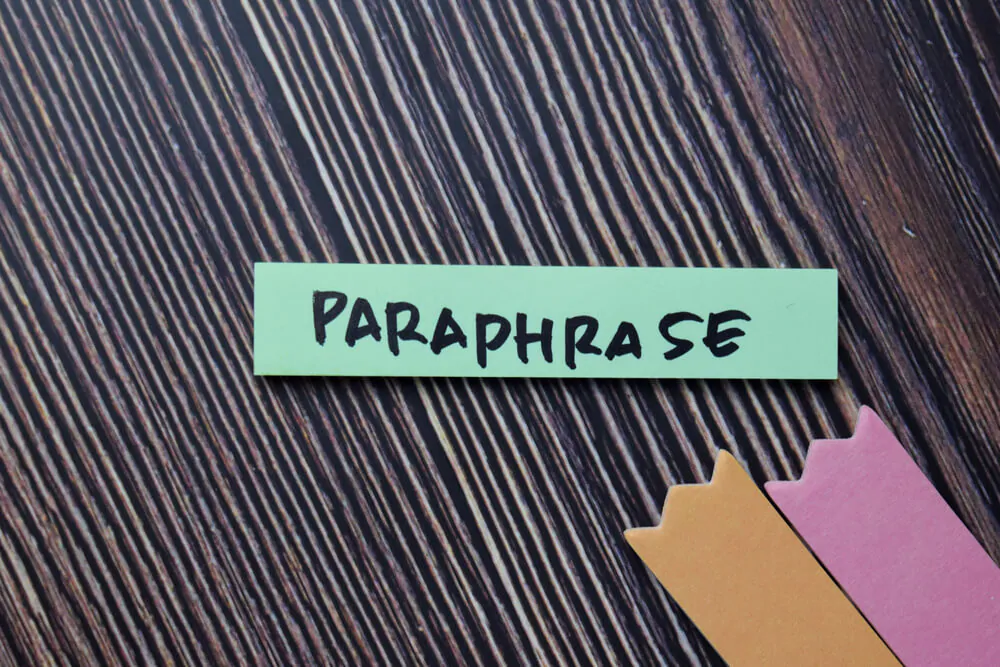When you write your next research paper, you may ask, “when should I use paraphrasing vs. quoting?” This guide will help you know.
The question of paraphrasing vs. quoting is important for writers. You must get this right in your writing to avoid plagiarism, create ethical written works, and make clear points.
Both paraphrasing and quoting are tools you can use to do this, but many writers do not know the difference between these two words. If you do not use them correctly and cite them appropriately, you could be guilty of plagiarism, which puts your academic or professional career at risk.
Quoting and paraphrasing are fairly similar, and they even require similar citations. Yet there are subtle differences you must understand, so you give the proper credit to the source. This guide will help you understand the difference between paraphrasing and quoting, so you can use both of these tools correctly in your next written piece.
When editing for grammar, we also recommend taking the time to improve the readability score of a piece of writing before publishing or submitting.
Contents
Paraphrasing vs. Quoting: When to Use Which
Paraphrasing and quoting are both processes to use another author’s work in your writing. They are confusing because they have different best-case uses. After you understand their differences, you will be able to decide how to use them in your writing.
What Is a Paraphrase?

A paraphrase is a restatement of an original author’s idea in your own words. It would help if you completely changed the wording from the source material to count it as a paraphrase. You may do so by changing the:
- Words
- Verb tense
- Sentence structure
However, you must keep the main points the same and properly attribute the source material’s author in your writing based on the style guide assigned to your projects, such as MLA or APA. Check out our allegory vs. symbolism explainer.
When to Use Paraphrases
Paraphrases are used when you want to restate a source and do not need to use the exact words to do so. It works well when you merge multiple sources into one written piece to
Paraphrases should make up the majority of your academic writing because you need to be able to convey the author’s ideas in your own words. Simply quoting many sources word-for-word does not show that you have truly understood the material and reached your conclusions.
How to Indicate a Paraphrase
Even though paraphrases are written in your own words, you will need to cite them when writing research papers and other types of academic writing. Failing to cite an idea from someone else and claiming it as your own violate copyright laws and is a form of plagiarism.
To cite a paraphrase, check the style guide or publication manual assigned to your project and add the citation appropriately. You might also be interested in our analogy vs. metaphor guide.
Tips for Paraphrasing
Paraphrasing can be a challenging skill to learn. To do it, you must be able to take someone else’s work and make it your own without changing the main ideas.
One tip that can make paraphrasing easier is reading the original text fully and closing it. Without opening it again, write your paraphrase. Then, look at the original text again to make sure the paraphrase seems unique but still conveys the right original thought.
What Is a Quote?

Quoting happens when you use the other author’s exact words. You change nothing of what they said, and you put the words in quotation marks or set them off with special indentation, depending on the length of the quote.
When to Use Quoting
Quoting works best when using your ideas or restating an original idea would weaken the key points. It also works well when you need to create a sense of authority in your statement and lack that authority as the author. Some times when a quote is the best choice over a paraphrase include:
- When using statistics and data from an authoritative source
- When quoting a piece of literature in a literary analysis paper
- When defining a word from a trusted dictionary
- When including a court decision in a piece of writing
Over-quoting is a common mistake in academic writing, especially with inexperienced writers. It shows little academic prowess to string together a bunch of quotes with attribution and call it your work. Use quotation sparingly and in those instances when it is necessary to make the point you need to make.
Keep in mind that not all written works require a quote. For most papers, one to two quotes are all that is necessary, if any are necessary at all. The rest of the work should be your ideas or paraphrases.
How to Format Quotes
Citing quotes is similar to citing paraphrases. You will use the APA, Chicago/Turabian, or MLA style citations. The main difference is that you must show that the piece is a quote.
Often, you will include in-text citations to introduce the quote. For example, you may say:
An example of simile can be seen in Alcott’s Little Women when the author writes, “. . . she tried to get rid of the kitten which had scrambled up her back and stuck like a burr just out of reach.” (Alcott, 183)
In this quote, the author’s name and the resource both show up in the dialogue, but the writer still uses proper parenthetical citations at the end of the quote. The quote itself has quotation marks, indicating it is a quote, and ellipses that show it starts in the middle of the author’s sentence.
If your quote is 40 words or longer, you will use a block quotation. Each style guide has its formatting for block quotations, but this style sets off the quote by indenting it and changing the spacing, which is visually different from the rest of the paper. Block quotations do not use quotation marks.
Citations for Quotes, Paraphrases, and Summaries
Whether you quote, paraphrase, or summarize a work, you will cite it in the same way. The citation style is based on the style guide for your work. The works you cite in the text also get included in the works cited or bibliography page at the end of the paper.
APA Style Citation
If you are writing a paper that requires APA style, then you will use in-text citations in the following format:
(Author’s last name, year of publication, page number)
If you put the author’s name in the actual text in APA style, you can omit it in the parenthesis. If the publication has no date, you put n.d. instead of the date. If there is not a page number, you can put some other identifier, such as paragraph number, chapter, section, or timestamp. However, this is only necessary for direct quotes. The page number or its substitutes are not necessary for paraphrases.
MLA Style Citations
MLA style in-text citations follow this format:
(Author’s last name, page number)
Omit the page number for this format if it is unavailable in the source.
Chicago/Turabian Style Citations
Chicago style requires a more complex citation format. It uses footnotes for both paraphrases and quotes. The first time you use a resource, you use this format for the footnote:
The author’s first and last name, title (publication city: Publisher, date), and the page number.
For additional citations using a previously listed resource, use this format:
Author last name, abbreviated title, page number.
Summarizing and Paraphrasing
Another consideration in this discussion is the idea of summarizing. Summarizing a work means condensing it to its main points. Typically, a summary is much shorter than the original work, while a paraphrase is fairly similar in length.
Like quotes and paraphrases, summaries require in-text citations in the expected format. You will choose to summarize if you are taking a large work, like a full book, report, or speech, and using most of its key points in your report.
The Issue of Common Knowledge
With quotes, paraphrases and summaries, you must cite the source any time you use someone’s ideas in your writing or quote someone directly. However, you do not have to cite something if it is considered common knowledge, even if you found the information in another work. As long as you are not taking a direct quote, if the fact is common knowledge does not require citation.
According to MIT, something is common knowledge if it is “information that the average, educated reader would accept as reliable without looking it up.” For example, if you said that the sky is blue, you would not have to cite this because most people know and accept this as fact.
The idea of common knowledge becomes tricky when you are doing academic writing. Sometimes, a fact is a common knowledge to the chosen audience for your work. For example, laws of physics may not be something the average person knows, but a physicist or scientist would, and you may not have to cite the place you found the law if you are writing for an academic group.
How to Decide if Something Is Common Knowledge
Some questions that can help you decide if something is common knowledge include:
- Who is my intended audience?
- What does my intended audience know?
- Is this an accepted fact in my field or niche?
- Is there a specific fact or statistic being cited, or just general knowledge they already know?
After answering these questions, you might have a better idea of whether or not your information is common knowledge. If it is, then you don’t have to cite it. If you are not sure, go ahead and cite it. Better to cite too often than to end up being guilty of plagiarism.
A Final Word on Paraphrasing Vs. Quoting
Paraphrasing and quoting both have a place in academic writing. However, quoting, which refers to using another writer’s exact words, needs to be sparse in your work. Writing a work primarily of quotes is not really writing; it’s just taking other people’s work and putting it together in a new format.
Paraphrasing is far more common. Paraphrasing keeps the original meaning of the work but changes the wording into your own words. This strategy shows that you have understood the meaning of the works you cite but have pulled that out and used it to support your ideas and thesis statement. Most of your academic writing should be paraphrased, supporting your thoughts, ideas, and conclusions.
Regardless of whether you are quoting or paraphrasing, you will need to cite your sources for any idea you use that is not common knowledge or your idea. If in doubt, cite your source to avoid falling victim to plagiarism, leading to academic dismissal or a failing grade on your project.
FAQs about Paraphrasing vs. Quoting
What is the difference between paraphrasing and quoting?
When paraphrasing something, you reword it but keep the main idea in place. The structure of the sentences and the words themselves must be different. When you quote something, you use the writer’s actual words word-for-word, placing the quote within quotation marks or blocking text.
Are summarizing and paraphrasing the same?
No, but summarizing and paraphrasing are similar. You are condensing the original work into its main points when you summarize. When paraphrasing, you restate the work in your own words without condensing. Both require citations, and both are good strategies to use in an academic or research paper.
Grammarly is one of our top grammar checkers. Find out why in this Grammarly review.